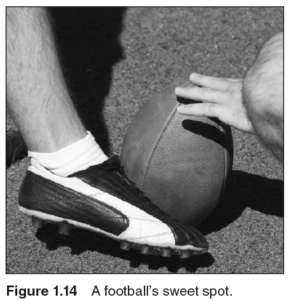Proper contact with ball is important for the kicker
This is an excerpt from Football Kicking and Punting by Ray Guy,Rick Sang.
Impact With the Sweet Spot
For a soccer-style kicker, the sweet spot of the ball is about 1 ½ to 2 ½ inches down from the ball's widest segment (figure 1.14). Contacting this area of the ball on the kick is most effective to achieve the optimal height and distance. When the holder positions the football in a straight up-and-down position, the kicker has a greater opportunity to strike the sweet spot.

Because the ball is a prolate spheroid shape, its axis of symmetry is longer than its other axes. This means the ball has a natural curve from its midsection that continues inward and to both points of the ball. When the football is positioned for placement-vertically for maximum sweet spot exposure-the inward curving of the ball from the midsection down to the point of placement on the ground provides the ideal surface area for contact on the kick. When the kicker strikes the ball as the kicking foot ascends, the ideal impact surface of the football and the top of the foot are more likely to meet, making for optimal impact and compression.
On contact with the ball, the kicker's upper body is angled back slightly and away from the ball. Contact occurs at the exact moment the kicking foot begins to ascend. The kicking leg is rotated inward slightly as the kicking foot remains locked at the ankle with toes pointing down and out. The kicking leg should be in a nearly locked position.
The inward rotation of the kicking foot allows contact to occur at the top of the foot. This motion enables the leg to rotate slightly, allowing the knee of the kicking leg to move forward and face the direction of the target. At the moment the ball begins to compress, the impetus of the body-including the plant foot, hips, and leg swing-comes together to maximize the energy transfer through the football. At this moment, all the mechanics of the kick coordinate with the direction of the plant foot, which has transitioned to a firm and flat position, and come together to focus all energy directly toward the target.
At the very moment the football is compressed, the kicking leg locks. The kicker's hips are square to the target and should continue forward in a thrusting motion, allowing for optimal power through the football. The left arm begins to sweep forward to counterbalance the anticipated swing of the kicking leg and provide stability as the body's energy becomes concentrated toward the target. The right arm is slightly behind the body as it counterbalances the plant foot and the swing of the left arm.
The lean of the kicker's body positions his head at an angle above and almost directly over a spot slightly behind and to the outside edge of the plant foot. This natural positioning of the body provides an optimal viewpoint. As the body continues the slight lean, with chest, hips, and kicking leg in a direct line to the kicking foot, the kicker looks down his body with eyes focused intently on the ball.
Optimal Trajectory
On impact, the kicker's body is slightly back and angled away from the ball, which allows him to kick up and through the ball, gaining immediate elevation to clear the ball over the oncoming rush. This is the kicker's natural way of adjusting his center of gravity to get a quick lift on the ball.
Optimal trajectory means obtaining maximum height and distance on the football to clear 10 feet easily from a 7-yard distance. An extra point or field goal is kicked 7 yards behind the line of scrimmage, where the potential blockers are swarming. Oncoming rushers can jump about 10 feet in the air. Thus, once the kick is on its way it must immediately climb above 10 feet before it travels 7 yards.
More Excerpts From Football Kicking and PuntingSHOP

Get the latest insights with regular newsletters, plus periodic product information and special insider offers.
JOIN NOW


